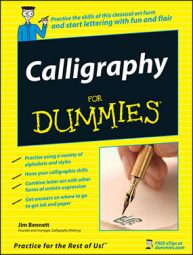Markers are great when time, not quality, is a consideration in your calligraphic work. You wouldn't want to use a marker to letter a certificate, but a marker would be perfect for small tasks such as writing a note to a friend or co-worker or posting a reminder to yourself or for family members. Markers are also excellent for children.
Markers have many limitations:
- You really can't produce good quality work with a marker. The writing tip is simply not fine enough to make the sharp edges and fine hairlines that a good pen will give you. Note, however, that the quality of markers is constantly improving, and the markers of today are far superior to the ones of just a few years ago.
- Ink fades with age. However, some brands of markers offer permanent, archival-quality ink.
- Markers tend to dry out quickly.
- The tip deteriorates. Even with careful use, the tips on markers have a tendency to lose their sharpness. The chisel-edge becomes blunted with use.
- Markers write, even when you're holding them wrong. In learning calligraphy, it is necessary to practice the correct way to hold the pen to produce the desired strokes and shapes, so using a marker isn't a good idea. A calligraphy fountain pen or dip pen helps a person learn how to hold the pen correctly because it will not write otherwise. A marker will write no matter how you hold it.
In spite of their limitations, markers are extremely useful. The main advantage of markers is how handy they are. They are the ultimate no-fuss-no-muss calligraphy pen. And when they run out of ink, you simply toss them in the trash.
When you're buying markers, test them in the store first. You never know unless you test it if a marker has already dried out. Also, make sure that your markers are tightly capped when you're not using them. Use force when you recap a marker to make sure the cap is snug.
The markers listed here are just a few of the most reliable ones. All of these markers come in a variety of colors:
- The Itoya doubleheader: This marker lets you write with both ends. The smaller tip is 1.7mm and the larger one is 3.5mm.
- Marvy 6000 Calligraphy Marker: The tip gives nice sharp lines, and the ink is dark. This marker comes in three sizes — 2.0mm, 3.5mm, and 5.0mm.
- Niji Calligraphy Marker: The ink in this marker is especially dense. Niji Calligraphy Markers are available in sets of three. The tips are 2mm, 3.5mm, and 5mm.
- Speedball Elegant Writer: This marker was one of the first to be designed to approximate the calligraphy pen. The tip sizes have the names X-Fine, Fine, Medium, and Broad.
- Staedtler Calligraph duo marker: This marker writes with either end! One end has a 2mm chisel tip and the other a 5mm tip. This marker comes in a variety of colors, and the ink is waterproof. Staedtler products are all excellent quality.
- The Zig Calligraphy Marker: This marker was designed primarily to meet the needs of scrapbookers and represents a big step upward in the quality of markers. The ink is permanent and archival quality (which means that it will not fade or change color, and because the ink is acid-free, it will not harm the paper that it is written on). There is an assortment of colors as well. One end of each marker is 2mm round for drawing, and the other is 5mm chisel-shaped for calligraphy.

